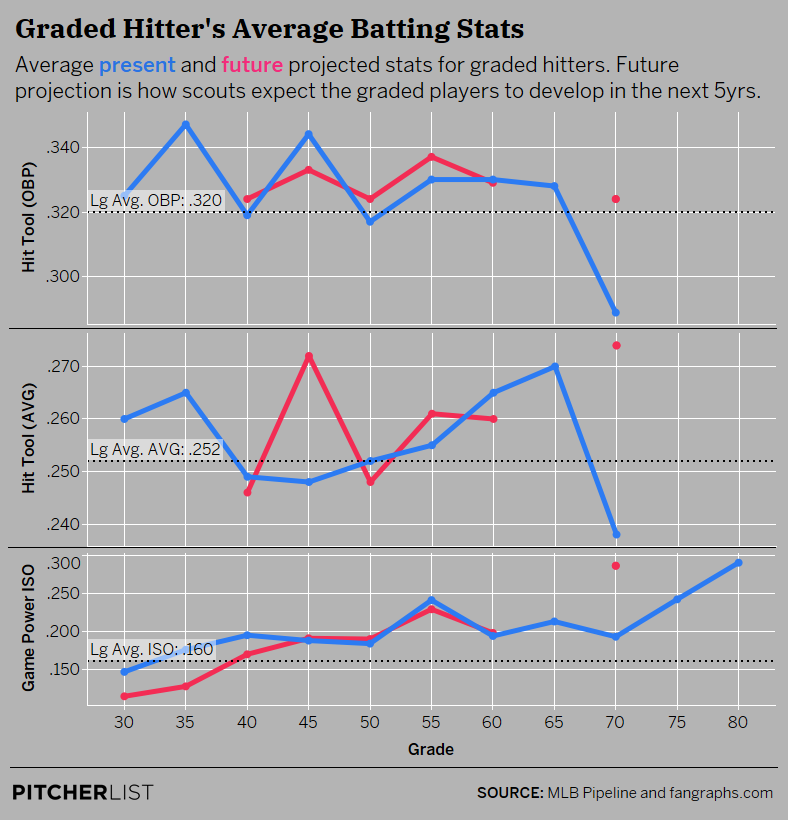The skills or tools of baseball prospects are frequently graded on a 20-80 scale. At first, this may seem arbitrary, but apparently, it is fairly common. 50 is average. Each level is one standard deviation from the average. 40 is one standard deviation below, 60 is one above, 30 is two below, etc. These 3 standard deviations above and below capture 99.7% of what is below a normally distributed curve, that is why there is little need to go beyond 20-80. Sometimes tools will receive a “half” grade of 55 for example. You will sometimes also see the scale described as 2-8.
Batter Tool Breakdown
Fantasy-relevant batter tools are Hit, Game Power, Raw Power, and Speed. Different scouting organizations may use slightly different terminology, but they are self-evident. Each of these tools is frequently broken down into Present and Future value. Future tool grades represent how a player is expected to develop in that area. Present and Future grades can differ greatly for Hit and Game Power. However, Raw Power and Speed potentials are reached at relatively young ages so don’t often increase. In many cases, the Future Speed tool is slightly lower than the Present grade, as athleticism declines with age.
Below is how these tools are typically expected to translate into on-field stats.
| Tool | Objective Statistic |
|---|---|
| Hit | Batting Average/OBP |
| Game Power | ISO |
| Raw Power | Max EV |
| Speed | Sprint Speed |
There are other stats associated with these tools. Hit tool and Contact Rate. Game Power and Slugging%/HRs. Raw Power and HRs/Max HR distance. I thought that those included in the chart above made the most sense, however. And correlations typically backed this up.
Past Tool Grades
I was curious about how these tool grades manifested once prospects became established Big Leaguers. After all, we don’t get excited for a high tool grade in and of itself. We are excited about a strong hit tool resulting in a .310 average, or 70-grade Game Power becoming 40 HR seasons.
Compiling tool grades of former prospects was surprisingly difficult. It primarily involved manually entering grades from a combination of Fangraphs and MLB Pipeline. I was able to find grades dating back to 2013. Most, if not all, players were on Top 100 lists. Future and Raw Power grades were also less frequently listed, resulting in a smaller sample size for those.
As most hitting stats have stabilized after 1,000 PAs, I used that as a cutoff for including former prospects. For Present Hit, Game Power, and Speed tools 75 players were selected. For Future Hit and Game Power, 40 players were found. For Present Raw Power, 27 players were selected. Future Raw Power and Future Speed were too similar to their Present grades to be significant and, therefore, were not included in final results for simplicity.
MLB Correlations
I ran a correlation with each tool grade and various stats. The closer the coefficient is to positive or negative one, the stronger the correlation. A negative number indicates that a higher grade is correlated to a lower outcome stat, and vice versa. Generally, anything above .7 is considered a strong correlation, between .5-.7 moderate, and less than .5 is weak.
| AVG | ISO | BB% | K% | wRC+ | Sprint Speed | EV | Max EV | OBP | |
|---|---|---|---|---|---|---|---|---|---|
| RawPresent | 0.10 | 0.76 | 0.31 | 0.39 | 0.51 | -0.35 | 0.78 | 0.68 | 0.22 |
| GamePowerFuture | 0.27 | 0.64 | 0.30 | 0.25 | 0.54 | -0.31 | 0.65 | 0.60 | 0.30 |
| GamePowerPresent | -0.15 | 0.45 | 0.33 | 0.33 | 0.26 | -0.35 | 0.50 | 0.54 | 0.13 |
| HitFuture | 0.28 | -0.05 | -0.07 | -0.20 | 0.02 | -0.14 | 0.01 | -0.04 | 0.06 |
| HitPresent | 0.06 | -0.06 | -0.09 | -0.22 | -0.05 | -0.18 | 0.01 | 0.09 | -0.04 |
| SpeedPresent | 0.03 | -0.40 | -0.27 | -0.04 | -0.29 | 0.72 | -0.44 | -0.32 | -0.17 |
The most obvious example here is the strong correlation of .72 for the Speed Grade and Sprint Speed. One would certainly expect this.
What is most surprising to me is the weak correlation with the Hit grades to, well… everything. The Hit tool is somewhat abstract, but it can be best thought of as representing contact and plate discipline skills. It does correlate most strongly here with Avg and a lower K%, but even that is pretty weak. Guys who don’t strike out a lot have a better batting average. There is no connection here between walk% and Hit tool, however.
Power, both Game and Raw, definitely stand out here. They are moderately correlated with ISO, wRC+, Exit Velocity, and Max Exit Velocity. While intuitive, it is also interesting to note that players with more power tend to be slower. That is why it is so special when the rare power/speed combo is present.
Based on this, if your only plus offensive tool is Speed, you better be a very good defender. The negative correlation with ISO is even starker when the ability to stretch singles into doubles should increase one’s ISO somewhat.
MLB Translations
How have these bucket grades actually converted to big-league stats? Here I’ll focus on the impacts on the expected objective stats given in the above table.

Data Visualization by @Kollauf on Twitter
Hit tool grades really have not shown us much in terms of batting average and OBP. In case you were wondering, removing that drop in BA and OBP at the 70 grade (ahem Byron Buxton) only changes the correlation coefficient for Present Hit to .09 and .00, respectively.
Given the above correlation, the Game Power grades definitely show an upward trend in ISOs.
I thought a table would suffice for Raw Power and Speed.
| Grade | Raw Power-Present (Max EV) | Speed-Present (Sprint Speed) |
|---|---|---|
| 20 | ||
| 25 | ||
| 30 | 25.3 | |
| 35 | ||
| 40 | 109.0 | 26.5 |
| 45 | 112.3 | 26.8 |
| 50 | 111.9 | 27.3 |
| 55 | 112.7 | 27.3 |
| 60 | 115.0 | 28.2 |
| 65 | 28.4 | |
| 70 | 117.6 | 28.3 |
| 75 | 29.1 | |
| 80 | 29.4 | |
| MLB Average | 27.0 |
Final Thoughts
I would’ve very much liked to have a larger sample size for this work, but it was not plausible at this time. It was a bit surprising to see how little the Hit tool translated into MLB results and how much Game and Raw Power did. Based on this it seems that a prospect with plus Power grades and just enough of a Hit tool is far more likely to have success than one with a plus Hit tool and average Power. Speed is a bonus, but a player needs much more to be successful at the plate. The all-encompassing wRC+ correlations back this up.
Photo by John Byrum/Icon Sportswire | Adapted by Michael Packard (@designsbypack on Twitter & IG)


Interesting. So, the hit tool is suppose to translate to BA and OBP. However, it not only has a weak correlation with BA, it actually has a negative correlation with BB% and virtually no correlation with OBP. Why do you think that is? Could it be that scouts are putting too much emphasis on contact % and not enough on plate discipline/batter’s eye? The power tool actually has the strongest correlation with BB% and OBP (although it is still relatively weak). I’m guessing this is because the prototypical power hitter is more patient – (hopefully) anticipating the pitch he wants to crush. Do you agree? The strongest correlation on your chart is power to ISO. But, I always thought the best way to determine a prospect’s success at the plate in the majors was to look at their MiLB BA, OBP and K% as well as their contact % the first season they are called up (and those with mediocre power may develop more as they mature). What do you think? Thanks
I think the OBP and walk% bump power guys get is from the pitcher’s increased willingness to pitch around them as they can do more damage. Walking a singles hitter seems worse than walking a big HR threat. This suggests that in some cases the power threat may be a stronger OBP predictor than true plate discipline skills
100% correct. I’ve been down this wormhole
Part1
https://fantasy.fangraphs.com/minors-to-the-majors-hitter-prospect-grades-part-1/
Part2
https://fantasy.fangraphs.com/minors-to-the-majors-hitter-prospect-grades-part-2/
Part3
https://fantasy.fangraphs.com/minors-to-the-majors-hit-tool-grade-usefulness/
Part4
https://fantasy.fangraphs.com/hit-tool-examination-pt-2-necessary-changes/
“I believe I am making this study about two years too soon. I would love for there to be more MLB information after the player received his grades and his 4-5 year production. I don’t have that luxury right now.” It was eerie seeing how many of my thoughts/experiences on this topic you put into words. Also, Buxton…
I do think your idea of reverse-engineering the Hit tool from established veterans is the way to go, if there is one. If not, simply thinking of Hit as contact and plate discipline skills is best. It may be time to largely disassociate it from batting average.
I may try to do a similar piece on Defensive grades and the various defensive metrics (e.g. OAA, UZR) in the near future.
Great stuff.
Curious to know how the FG grades performed vs. the MLB grades?
Thank you. All Future grades came from Fangraphs and roughly 2/3s of Present grades came from MLB. I wouldn’t read too much into that stuff though
Thanks. Any plans to do a similar analysis on pitchers?
Possibly in a few months.